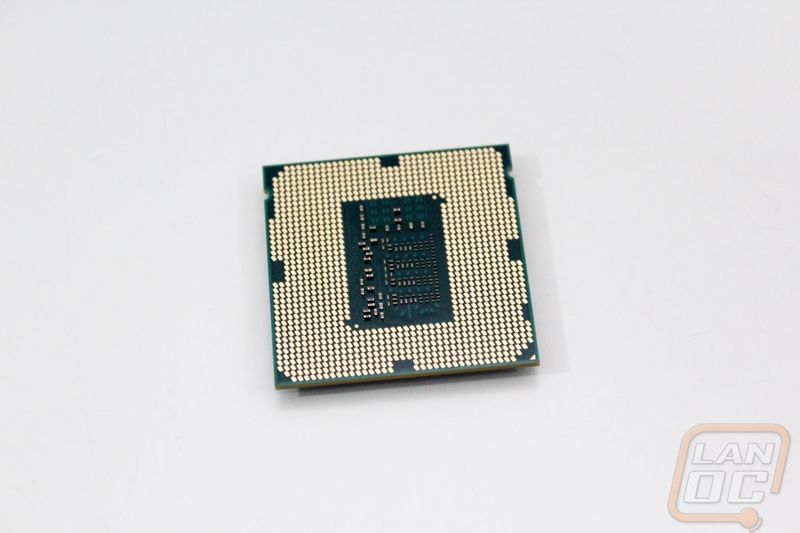When it comes to CPUs there are only a few options available when you are looking for the fastest performance. Up until now you could go with a Haswell CPU or if you wanted more cores The Ivy Bridge-E CPUs. AMDs has done well on the integrated GPU side of things but for pure CPU power Intel has been the only way to go. Recently Intel announced their latest refresh with their Devil’s Canyon CPUs. Today I finally have the chance to put the i7-4790k to the test and see what kind of improvement it is over the i7-4770k.
Product Name: Intel i7-4790K Devil’s Canyon
Review Sample Provided by: Intel
Written by: Wes
Pictures by: Wes
Devil’s Canyon
Rather than just post up the specifications, I wanted to take a quick look to see what sets Devil’s Canyon apart from Haswell. The truth of the matter is this is a very small refresh compared to some in the past. In short, they took a Haswell processor and changed the thermal interface material between the CPU and the cover to help improve its cooling. Additionally they added more capacitors to smooth the power delivery. Those two hardware changes allowed them to increase the base frequency all the way up to 4GHz on every single core. In other words, they cooled things down and overclocked the i7-4770k. If you have been following Intel’s Tick and Tock roadmap, Haswell was a Tock and this is just another Tock. We will get the Tick with Broadwell at a later date.

You still get the same Intel HD Graphics 4600 that the i7-4770k had and they both run at 1250MHz, so don’t expect to see any improvements there beyond what the increase in CPU performance will give you. Speaking of that, the increase in base clock also means that the maximum turbo frequency was bumped up as well. With the turbo the 4790k can run up to 4.4GHz, an impressive number.




|
Processor |
I7-4770k |
I7-4790k |
|
Codename |
Haswell |
Devil’s Canyon |
|
TDP |
84W |
88W |
|
Cores/Threads |
4/8 |
4/8 |
|
CPU Base Freq (GHz) |
3.5 |
4.0 |
|
Max Turbo Freq (GHz) |
3.9 |
4.4 |
|
DDR3 (MHz) |
1333/1600 |
1333/1600 |
|
L3 Cache |
8MB |
8MB |
|
Intel® HD Graphics |
4600 |
4600 |
|
Intel® Wireless Display |
Yes |
Yes |
|
Graphics Max Dynamic Frequency |
up to 1250MHz |
up to 1250MHz |
|
Intel® Hyper-threading Technology |
Yes |
Yes |
|
Intel® Advanced Vector Extensions (AVX) |
Yes |
Yes |
|
Intel® Quick Sync Video |
Yes |
Yes |
|
Intel® vPro / TXT / VT-d / Intel® SIPP |
Yes |
Yes |
|
Intel® AES-NI |
Yes |
Yes |
|
Intel® Virtualization Technology |
Yes |
Yes |
|
PCI Express 3.0 |
Yes |
Yes |
|
Socket |
LGA-1150 |
LGA-1150 |

The Z97 platform also launched with Devil’s Canyon (with the original launch not the launch of the k CPU that we are covering today), this chipset brought other improvements with it as well. For starters, it supports 4th and 5th generation Core processors. That means Z97 boards will run Haswell, Devil’s Canyon, and in the future Broadwell CPUs. They added Device Protection with Boot Guard to help protect against malware that like to target the boot block. The main change with Z97 was how it handles storage devices. Specifically adding support for M.2 and/or SATA Express. This opens up even more performance for SSD’s in the near future. With that said, a lot of the Z87 motherboards will support Devil’s Canyon with upgraded firmware, but before you consider that be sure to double check and also make sure you have access to a Haswell CPU to run the update. Going with Z87 would mean you couldn’t benefit from the faster storage options as well as no support for Broadwell in the future, but you might be able to find the boards a little cheaper.


